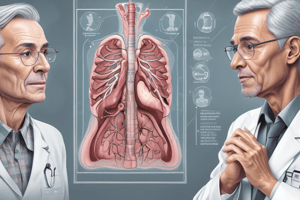Podcast
Questions and Answers
What is the primary purpose of respiration?
What is the primary purpose of respiration?
- To increase CO2 levels in the tissues
- To take O2 into the body for tissue utilization (correct)
- To transport CO2 out of the lungs
- To remove O2 from the body
How does gas movement between the lungs and tissues primarily occur?
How does gas movement between the lungs and tissues primarily occur?
- Facilitated diffusion
- Active transport
- Endocytosis
- Simple diffusion (correct)
Which gas has the highest partial pressure in human cells?
Which gas has the highest partial pressure in human cells?
- CO2 (correct)
- N2
- O2
- H2
In which direction does CO2 move between the cells and venous blood?
In which direction does CO2 move between the cells and venous blood?
What happens to PaCO2 levels if CO2 production increases while VA remains constant?
What happens to PaCO2 levels if CO2 production increases while VA remains constant?
What is the normal range for PACO2?
What is the normal range for PACO2?
What does the alveolar air equation account for?
What does the alveolar air equation account for?
What determines the partial pressure of N2 in alveolar gas?
What determines the partial pressure of N2 in alveolar gas?
What is the normal ratio of CO2 compared to oxygen in the lungs?
What is the normal ratio of CO2 compared to oxygen in the lungs?
Which gas has no role in gas exchange but occupies space and exerts pressure in the lungs?
Which gas has no role in gas exchange but occupies space and exerts pressure in the lungs?
What is the prime determinant of partial pressure of CO2 (PACO2) in the lungs?
What is the prime determinant of partial pressure of CO2 (PACO2) in the lungs?
What is the main barrier to gaseous diffusion in the lung?
What is the main barrier to gaseous diffusion in the lung?
Which of the following is required for gases like CO2 or O2 to move between alveoli and the pulmonary capillary blood?
Which of the following is required for gases like CO2 or O2 to move between alveoli and the pulmonary capillary blood?
According to Fick's law, what factors contribute to more diffusion occurring?
According to Fick's law, what factors contribute to more diffusion occurring?
In a normal lung, what does diffusion primarily depend on?
In a normal lung, what does diffusion primarily depend on?
When will PaO2 not be any higher than 120 mmHg during hyperventilation?
When will PaO2 not be any higher than 120 mmHg during hyperventilation?
What occurs along pressure gradients in terms of pulmonary diffusion gradients?
What occurs along pressure gradients in terms of pulmonary diffusion gradients?
What accounts for 3/4 of the normal difference between PAO2 and PaO2?
What accounts for 3/4 of the normal difference between PAO2 and PaO2?
Which condition arises when venous blood enters areas with V/Q ratios of 0?
Which condition arises when venous blood enters areas with V/Q ratios of 0?
What mainly causes regional variations in V/Q in the normal lung?
What mainly causes regional variations in V/Q in the normal lung?
Where do exchange units with V/Q values of 0 occur?
Where do exchange units with V/Q values of 0 occur?
Which part of the lung has a high V/Q ratio typically above 1?
Which part of the lung has a high V/Q ratio typically above 1?
What does mixing of well-oxygenated arterial blood with poorly oxygenated blood cause?
What does mixing of well-oxygenated arterial blood with poorly oxygenated blood cause?
Which gas has a higher solubility in plasma, leading to faster diffusion across the alveolar-capillary membrane?
Which gas has a higher solubility in plasma, leading to faster diffusion across the alveolar-capillary membrane?
What is the approximate time that blood leaving the lungs is normally exposed to alveolar gas for proper equilibration?
What is the approximate time that blood leaving the lungs is normally exposed to alveolar gas for proper equilibration?
What is the typical PO2 of blood leaving the tissue capillaries after equilibration?
What is the typical PO2 of blood leaving the tissue capillaries after equilibration?
What causes carbon dioxide to diffuse in the opposite direction, from blood into the alveolus?
What causes carbon dioxide to diffuse in the opposite direction, from blood into the alveolus?
What is the primary cause of anatomic shunts that lead to a lower PaO2 than calculated PAO2?
What is the primary cause of anatomic shunts that lead to a lower PaO2 than calculated PAO2?
Why does blood move from the tissue capillaries back into the cells after equilibration?
Why does blood move from the tissue capillaries back into the cells after equilibration?
Study Notes
Purpose and Mechanics of Respiration
- Primary purpose of respiration is to exchange gases: oxygen intake and carbon dioxide removal.
- Gas movement between lungs and tissues mainly occurs through diffusion driven by concentration gradients.
Gaseous Composition and Movement
- Oxygen has the highest partial pressure in human cells.
- Carbon dioxide (CO2) moves from cells into venous blood, balancing internal production and arterial release.
CO2 Production and Levels
- If CO2 production increases while alveolar ventilation (VA) remains constant, PaCO2 levels rise.
- Normal range for arterial PACO2 is typically 35-45 mmHg.
Alveolar Air Equation and Composition
- Alveolar air equation accounts for the partial pressures of gases in alveoli, reflecting discrepancy between alveolar and arterial oxygen tensions.
- Partial pressure of nitrogen (N2) in alveolar gas is determined by its concentration in inspired air and the total atmospheric pressure.
Gas Ratios and Roles
- Normal CO2 to oxygen ratio in the lungs is around 1:4.
- Nitrogen has no role in gas exchange but occupies space and exerts pressure in the lungs.
Determinants of Gas Exchange
- Prime determinant of PACO2 in the lungs is the rate of CO2 production relative to its elimination.
- Main barrier to gaseous diffusion in the lung is the alveolar-capillary membrane.
Requirements and Influencing Factors
- Gases like CO2 or O2 require a concentration gradient and sufficient membrane surface area for diffusion between alveoli and pulmonary capillary blood.
- According to Fick's law, diffusion increases with larger surface area, steeper gradients, and lower molecular weight gases.
Diffusion Dependence and Limits
- In normal lungs, diffusion primarily depends on the surface area and distance across the alveolar-capillary membrane.
- During hyperventilation, PaO2 may not exceed 120 mmHg due to limitations in oxygen solubility and transport.
Pressure Gradients and V/Q Relationships
- Pulmonary diffusion occurs along pressure gradients between alveolar gas and blood.
- Approximately three-quarters of the normal difference between PAO2 (alveolar oxygen pressure) and PaO2 (arterial oxygen pressure) is attributed to shunting and ventilation-perfusion ratios.
Ventilation-Perfusion Ratios
- Conditions arise when venous blood enters areas with ventilation-perfusion (V/Q) ratios of 0, leading to hypoxemia.
- Regional variations in V/Q in the normal lung are mainly caused by gravity, affecting blood flow distribution.
- Exchange units with V/Q values of 0 primarily occur in dependent lung regions.
High V/Q Ratios and Effects
- The apex of the lungs typically exhibits high V/Q ratios, often above 1.
- Mixing of well-oxygenated arterial blood with poorly oxygenated blood causes dilution of oxygen content in the arteries.
Gas Solubility and Diffusion
- Carbon dioxide has a higher solubility in plasma than oxygen, facilitating faster diffusion across the alveolar-capillary membrane.
- Blood normally spends around 0.75 to 1 second in pulmonary capillaries to allow for gas equilibration with alveolar gas.
Equilibration Dynamics
- Typical PO2 of blood leaving tissue capillaries after equilibration is around 40 mmHg.
- Carbon dioxide diffuses from blood into the alveolus due to higher concentration in the blood relative to the alveolar air.
Anatomic Shunts and Cellular Dynamics
- Primary cause of anatomic shunts leading to lower PaO2 than calculated PAO2 is blood bypassing ventilated alveoli.
- Blood returns from tissue capillaries into cells after equilibration due to concentration gradients favoring nutrient and gas exchange.
Studying That Suits You
Use AI to generate personalized quizzes and flashcards to suit your learning preferences.
Description
Test your knowledge on gas exchange, transport of O2 and CO2, and the process of respiration in the context of Egan’s Chapter 12. Explore concepts such as diffusion of gases between tissues and blood, as well as the movement of O2 from the lungs to the tissues.




